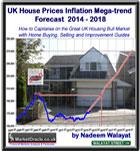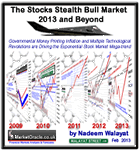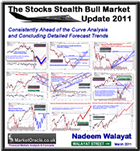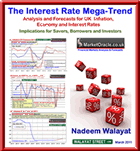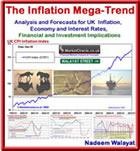Fed Remains Paralysed by Fear, Keeps U.S. Interest Rates on Hold at 0.25%
Interest-Rates / US Interest Rates Sep 18, 2015 - 07:24 AM GMTBy: Nadeem_Walayat
 The FOMC once more decided to do nothing and keep US interest rates on hold at the panic low level of 0.25% with speculation now switching to whether the Fed will finally get the balls to raise interest rates at its October meeting, or will the Fed chicken out once more fearing that they may spark Financial Collapse 2.0.
The FOMC once more decided to do nothing and keep US interest rates on hold at the panic low level of 0.25% with speculation now switching to whether the Fed will finally get the balls to raise interest rates at its October meeting, or will the Fed chicken out once more fearing that they may spark Financial Collapse 2.0.
I could argue the point that probability continues to favour at least one 25 basis point interest rate hike before the end of this year i.e. from 0.25% to 0.50%, but when one is dealing with a central bank that remains scared to death of financial armageddon, then the Fed could just keep dragging its heels, too scared to act well into 2016.
The FOMC statement offers few clues of when the Fed may move -
Information received since the Federal Open Market Committee met in July suggests that economic activity is expanding at a moderate pace. Household spending and business fixed investment have been increasing moderately, and the housing sector has improved further; however, net exports have been soft. The labor market continued to improve, with solid job gains and declining unemployment. On balance, labor market indicators show that underutilization of labor resources has diminished since early this year. Inflation has continued to run below the Committee's longer-run objective, partly reflecting declines in energy prices and in prices of non-energy imports. Market-based measures of inflation compensation moved lower; survey-based measures of longer-term inflation expectations have remained stable.
Consistent with its statutory mandate, the Committee seeks to foster maximum employment and price stability. Recent global economic and financial developments may restrain economic activity somewhat and are likely to put further downward pressure on inflation in the near term. Nonetheless, the Committee expects that, with appropriate policy accommodation, economic activity will expand at a moderate pace, with labor market indicators continuing to move toward levels the Committee judges consistent with its dual mandate. The Committee continues to see the risks to the outlook for economic activity and the labor market as nearly balanced but is monitoring developments abroad. Inflation is anticipated to remain near its recent low level in the near term but the Committee expects inflation to rise gradually toward 2 percent over the medium term as the labor market improves further and the transitory effects of declines in energy and import prices dissipate. The Committee continues to monitor inflation developments closely.
To support continued progress toward maximum employment and price stability, the Committee today reaffirmed its view that the current 0 to 1/4 percent target range for the federal funds rate remains appropriate. In determining how long to maintain this target range, the Committee will assess progress--both realized and expected--toward its objectives of maximum employment and 2 percent inflation. This assessment will take into account a wide range of information, including measures of labor market conditions, indicators of inflation pressures and inflation expectations, and readings on financial and international developments. The Committee anticipates that it will be appropriate to raise the target range for the federal funds rate when it has seen some further improvement in the labor market and is reasonably confident that inflation will move back to its 2 percent objective over the medium term.
The Committee is maintaining its existing policy of reinvesting principal payments from its holdings of agency debt and agency mortgage-backed securities in agency mortgage-backed securities and of rolling over maturing Treasury securities at auction. This policy, by keeping the Committee's holdings of longer-term securities at sizable levels, should help maintain accommodative financial conditions.
When the Committee decides to begin to remove policy accommodation, it will take a balanced approach consistent with its longer-run goals of maximum employment and inflation of 2 percent. The Committee currently anticipates that, even after employment and inflation are near mandate-consistent levels, economic conditions may, for some time, warrant keeping the target federal funds rate below levels the Committee views as normal in the longer run.
Voting for the FOMC monetary policy action were: Janet L. Yellen, Chair; William C. Dudley, Vice Chairman; Lael Brainard; Charles L. Evans; Stanley Fischer; Dennis P. Lockhart; Jerome H. Powell; Daniel K. Tarullo; and John C. Williams. Voting against the action was Jeffrey M. Lacker, who preferred to raise the target range for the federal funds rate by 25 basis points at this meeting.
Whilst at the press conference Janet Yellen appeared more eager to raise interest rates despite financial markets uncertainty, citing low unemployment.
The stock market did an about turn following the news where it gave up the Dow's initial near 200 point surge to end down 64 points on the day. My existing view is that it would have been better for stocks if the Fed HAD raised interest rates Thursday so as to get it out of the way as now virtually immediately market speculation has shifted to October's meeting and surely after that to Decembers.
13 Sep 2015 - Stock Market Dow Trend Forecast for September to December 2015
For the whole of 2015 there has been building expectations for the Fed to raise interest rates that had focused on September being the month. However, now that September is actually here, the question to be asked is will the Fed finally pull that trigger or will they err on the side of caution and delay for another month or so ?
In my opinion, whether the Fed raise rates or not this month does not really matter too much at this stage because it will be just a token move of raising rates from 0.25% to 0.50% rather than signaling a series of monthly rate hikes.
So whilst a rate hike would galvanise the bears to herald another stock market collapse as being imminent, the probable reality will be that when the dust settles the stock market will probably be trading several percentages higher a month after the first rate hike. Which means any dip in stocks following the first rate hike is likely to be temporary and nowhere near on the scale of the recent decline.
In fact stocks and housing are more likely to rise during a rate hiking cycle and fall during a cutting cycle which is the exact opposite of the consensus view! Which is common sense because interest rates are cut in times of economic weakness, recession, financial panics, whilst interest rates are raised to cool an over heating booming economy or in response to an Inflation panic, neither of which is taking place today with US CPI inflation of just 0.2% and GDP growth expectations of just 2.5%. So in economic terms, the case for significantly raising interest rates is just not there.
So despite a marginally better than 50/50 probability for a September rate hike, the overall interest rate outlook remains benign for stocks, that is until we either see either inflation soaring above the Feds 2% target or GDP racing towards 4%.
The Fed's paralysis suggests that in fact it may be the MARKET that forces the Fed to finally start raising interest rates, a plunging dollar perhaps?
The bottom line is that US interest rates rising from 0.25% to 0.5% would hardly have been a earth shattering event, and thus by delaying acting the Fed is signaling that even when the Fed does finally start to raise interest rates, which is anyone's guess, then it will be a very slow process, especially given the fact that Inflation is well below the Fed's 2% target so to we may only just manage to see rates rise to a paltry 1% by the end of 2016 which means continuing erosion of purchasing power (stealth theft) of savings.
Ensure you are subscribed to my always free newsletter for ongoing in-depth analysis and concluding detailed trend forecasts that include the following planned newsletters -
- US Dollar Trend Forecast Update 2015
- Islam 3.0
 Also subscribe to our Youtube channel for notification of video releases and for our new series on the 'The Illusion of Democracy and Freedom', that seeks to answer questions such as 'Did God Create the Universe?' and how to 'Attain Freedom' as well as a stream of mega long term 'Future Trend Forecasts'.
Also subscribe to our Youtube channel for notification of video releases and for our new series on the 'The Illusion of Democracy and Freedom', that seeks to answer questions such as 'Did God Create the Universe?' and how to 'Attain Freedom' as well as a stream of mega long term 'Future Trend Forecasts'.
By Nadeem Walayat
Copyright © 2005-2015 Marketoracle.co.uk (Market Oracle Ltd). All rights reserved.
Nadeem Walayat has over 25 years experience of trading derivatives, portfolio management and analysing the financial markets, including one of few who both anticipated and Beat the 1987 Crash. Nadeem's forward looking analysis focuses on UK inflation, economy, interest rates and housing market. He is the author of five ebook's in the The Inflation Mega-Trend and Stocks Stealth Bull Market series that can be downloaded for Free.
 Nadeem is the Editor of The Market Oracle, a FREE Daily Financial Markets Analysis & Forecasting online publication that presents in-depth analysis from over 1000 experienced analysts on a range of views of the probable direction of the financial markets, thus enabling our readers to arrive at an informed opinion on future market direction. http://www.marketoracle.co.uk
Nadeem is the Editor of The Market Oracle, a FREE Daily Financial Markets Analysis & Forecasting online publication that presents in-depth analysis from over 1000 experienced analysts on a range of views of the probable direction of the financial markets, thus enabling our readers to arrive at an informed opinion on future market direction. http://www.marketoracle.co.uk
Disclaimer: The above is a matter of opinion provided for general information purposes only and is not intended as investment advice. Information and analysis above are derived from sources and utilising methods believed to be reliable, but we cannot accept responsibility for any trading losses you may incur as a result of this analysis. Individuals should consult with their personal financial advisors before engaging in any trading activities.
Nadeem Walayat Archive |
© 2005-2022 http://www.MarketOracle.co.uk - The Market Oracle is a FREE Daily Financial Markets Analysis & Forecasting online publication.




